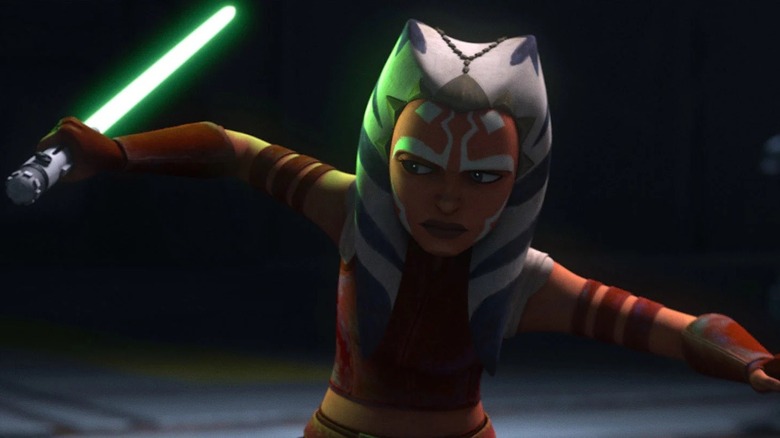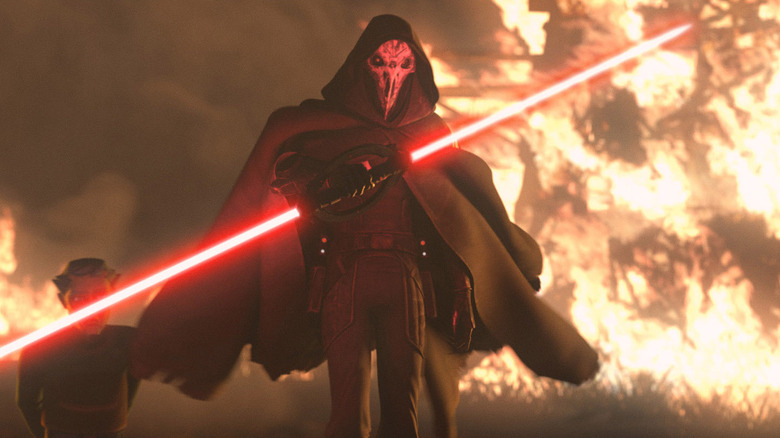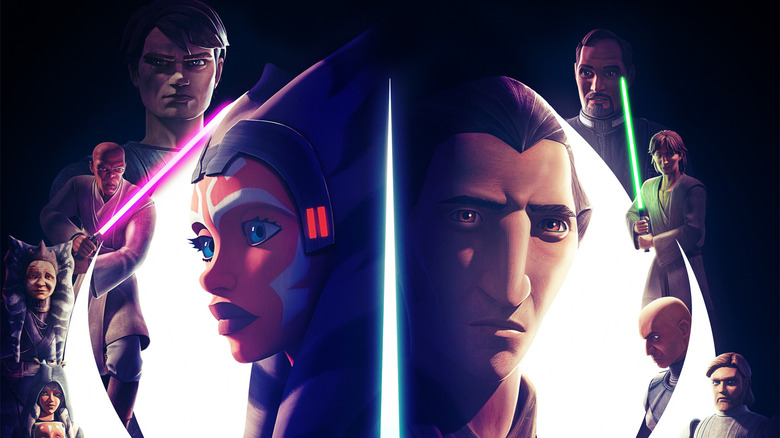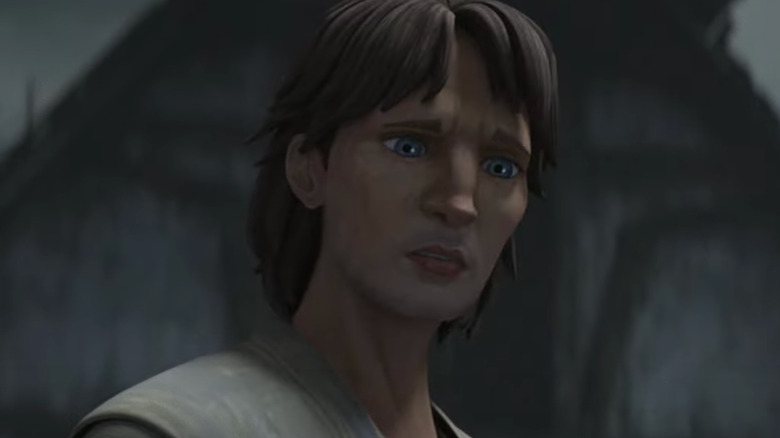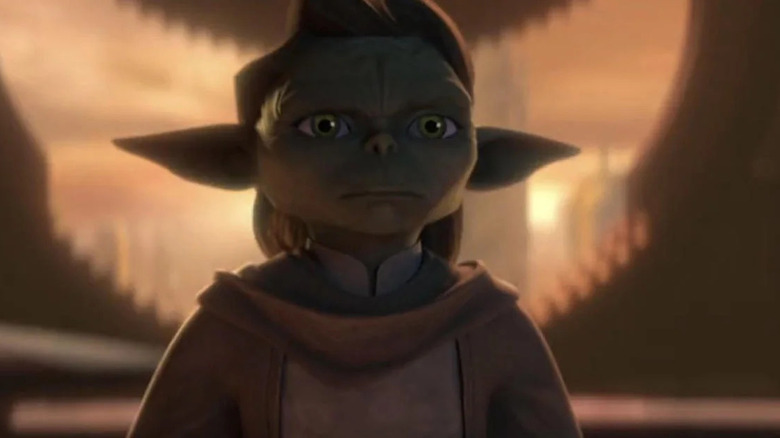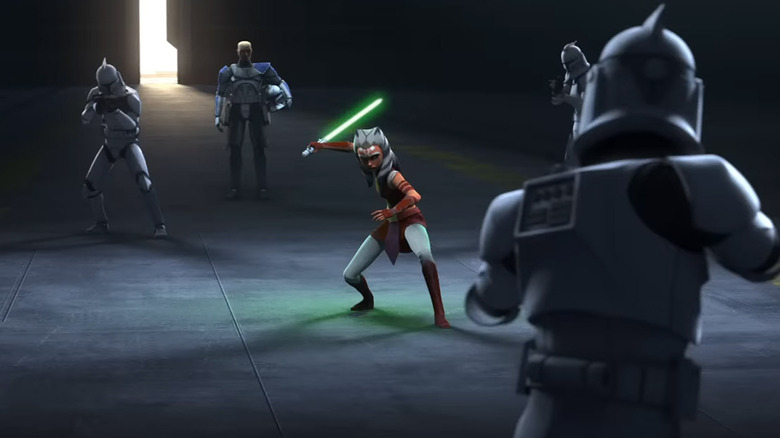Star Wars: Tales Of The Jedi Review: A Series Full Of Stunning Animation, Pathos And Galaxy Lore
There will be spoilers for "Star Wars: Tales of the Jedi"
"Star Wars: Tales of the Jedi" is a six episode mini-series featuring stories that take place before, during, and after the prequel era, offering a window into the Jedi Order through the lens of two pivotal characters who both lost their faith in the Jedi: Count Dooku and Ahsoka Tano. With the exception of the first episode, this six episode arc follows a chronological order, starting long before the prequel movies, winding through the events of each of them from different points of view, and culminating in Ahsoka Tano remembering why it's important for her to fight the oppression and tyranny of the Empire.
The animation is stellar
The team George Lucas and Dave Filoni put together to form the nucleus of "Star Wars: The Clone Wars" has grown and evolved over the years, though many of the players remain the same. With each bite of the apple, the team has vastly improved the animation and lighting every single time. Although the animation started a little rough, these days, every frame is a painting, a singular work of art that tells stories beyond those being told in the text of the writing. The backgrounds are rendered in a way that makes them look like classic matte paintings, the light hits every figure with a beauty and style that adds to the story, the animation is fluid, graceful and truly defines performances. This is the best they've done so far, and it's worth noting.
In particular, there were scenes in the fourth episode, "The Sith Lord," that mimic the golden hour shots of Coruscant from "Revenge of the Sith" rather impressively, matched by Kevin Kiner's haunting score. These scenes between the film and the animation match visually and tonally, showing us the choices Dooku made and how they preceded that of Anakin Skywalker, both ending with the death of a Jedi Master and a new apprentice for Palpatine.
Two sides of the coin
When I first saw the announcement for this show at Star Wars Celebration, I didn't get the impression that the shorts would be as thematically linked as they are. On first blush, it seemed as though Dooku and Ahsoka would have very little in common, but seeing these six shorts strung together, they tell a story of two Jedi and their increasingly strained relationship with the Jedi order. Dooku's disillusionment brings him to joining with the Sith, Ahsoka's brings her back into the fight against oppression.
There is pain in both of them as they make their choices, which was something else I wasn't expecting. In other iterations of Dooku's story and his turn, he seems to be duplicitous and quick to anger, but this shows a pain behind his eyes and a difficulty in his choices. For Ahsoka, she's very much challenged, but this brings her pain and endurance to the forefront. Especially in the last two episodes, we see just how much damage the Clone Wars have done to everyone, even Padawans trying to find their way.
In the end, the pairing of Dooku and Ahsoka makes a poetic sort of sense in a way I would have never guessed.
Details to watch out for
This show being a Dave Filoni joint leaves it ripe for things to watch out for, but since the episodes are so short, none of it is overwhelming.
The first episode takes a lot of its cues and connections to nature from Hayao Miyazaki's "Princess Mononoke," which Dave Filoni has cited as one of his favorite films. Its influence can be seen throughout Dave Filoni's work in "Star Wars," and the small Togruta village feels as though it could be ripped from one of the more idyllic tableaus in Miyazaki's masterpiece. The themes of nature's connection are on full display as well.
But what "Star Wars" project would be complete without plenty of visual and tonal touchstones to the work of Akira Kurosawa? Pay particular attention to the second episode, "Justice", where the mist blows in on the evil, much like in Kurosawa's "Throne of Blood." The music Kevin Kiner brings to the table has that same steady drumbeat of dread that one finds in Kurosawa films like "Throne of Blood" and "Seven Samurai." The same influences can be seen in the finale as Ahsoka faces off against an Inquisitor on the burning farm.
Some of the more interesting bits of "Star Wars" fluff that got folded into these episodes include a call out of Qui-Gon Jinn's world of birth as Coruscant, something that had only been in sourcebooks before. There was also a cameo of a young Caleb Dume, the Padawan who would become Kanan Jarus on "Star Wars Rebels." His appearance here is too early for he and Master Depa Bilaba to be master and apprentice yet, but they're definitely spending some time together.
The other big one is the location of the third episode, "Choices." It takes place on Raxus Secundus. Fans of "Star Wars: The Clone Wars" will remember that as the site of the Separatist Senate. Ahsoka and Padmé travel there to meet Mina Bonteri and her son Lux when they plead for peace enough to end the war. This is where Dooku's political power will be strongest in the future.
The canon and the timeline
There are definitely some details that might leave fans scratching their heads, thinking that some bit of the canon has been broken or some such, but all of this really fits with what's been established.
Starting with Dooku and Yaddle's episode, "The Sith Lord," we see Dooku, long after he's resigned from the Jedi Order, wandering the grounds of the Jedi Temple, almost as a Jedi himself. The recent book, "Star Wars: Padawan" explains this is not the case. Dooku is still welcome in the Temple and treated with respect because no one knows how far his heart has turned to the dark side. It's why he's so easily able to use the codes of Jedi Master Sifo-Dyas to erase Kamino from the archive memory.
Then Master Yaddle (voiced by Bryce Dallas Howard) discovers Dooku's secret and confronts him alongside the timeline of "The Phantom Menace." It was thought that Yaddle might have survived Order 66, but when you look at everything in the canon after that film, the only sightings of Master Yaddle are purely in the realm of visions and flashbacks. There's nothing that says she makes it. This brutal end she meets is perfectly in fitting with the canon.
The larger question of canon comes from the final episode of the show: "Resolve." This retells events we've read in E.K. Johnston's magnificent book "Star Wars: Ahsoka," where Ahsoka confronts an Inquisitor as she's disguised on a farming planet. Is this Inquisitor the same? Does it matter?
There are two possible explanations for this. First, this is a compressed retelling of moments in that story. The story team has said that there will be variants to the canon because the medium the story is told in will sometimes require changes. This could be that for "Ahsoka." The other possibility is that Ahsoka finds herself on a different farm planet fighting a different Inquisitor. Neither theory is far-fetched, neither break the canon. And what is canon anyway, except a way to keep things straight?
Coda
These episodes are a return to form for "Star Wars" animation. "The Sith Lord" and "Practice Makes Perfect" are the standouts for me. "The Sith Lord" is a brutal look at Dooku's final choices to leave the Jedi order and what emotional toll that costs him, and it's done in such a compelling manor that mirrors Anakin's choices in "Revenge of the Sith," as it plays out in a familiar location from "Attack of the Clones." The other, "Practice Makes Perfect", is worth the price of admission alone. As Anakin tries to drill into Ahsoka a need to be better than the rest of the Jedi, mirroring his own need for more, he inadvertently gives her all of the skills she'll need to evade the Clones trying to apprehend her in the episode "The Wrong Jedi" and the wherewithal to survive against Rex and the boys during Order 66. Then, when the doors open, revealing a different view of that moment from the final episodes of "The Clone Wars" and Rex and Ahsoka have to face off against an entire legion of troops bearing Ahsoka's face pattern in her honor, it breaks the heart.
These episodes are full of pathos and interesting connections to the broader "Star Wars" lore. The quality of work from the writers, from Lucasfilm Animation, and the music of Kevin Kiner has never been better. My hope is that these mini-episodes are popular enough to spin more Jedi into the limelight for more tales. Who knows what else could be revealed?
All six episodes of "Tales of the Jedi" are now streaming on Disney+.
